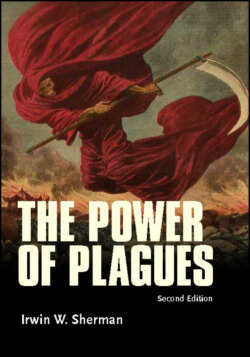Читать книгу The Power of Plagues - Irwin W. Sherman - Страница 32
The Justinian Plague
ОглавлениеThe historian Procopius of Caesarea wrote in The Persian Wars that “it embraced the entire world and blighted the lives of all men.” He described the symptoms of the disease: great swellings, or buboes, appeared in the groin and armpit as the lymph nodes enlarged; there was delirium and frantic restlessness; and some became comatose. There was general hysteria and panic. If the buboes were lanced, there was the possibility of survival, but most died in 5 days. It raged in the city of Constantinople (present-day Istanbul), the capital of the Roman Empire in the East, for months, and so numerous were the corpses that they were cast into hollow towers of some incomplete fortifications.” Procopius’ eyewitness account claimed that 300,000 died, but this is probably an exaggeration. There is, however, no question that all of Europe suffered from this plague, and 5 years later it had reached Ireland, and by that time it had killed close to a million people.
This disease arrived in A.D. 541 and raged intermittently in Europe, North Africa, and the Middle East until 757. Called the plague of Justinian, it was probably bubonic plague that came to the Mediterranean from an original focus in northeast India or via central Africa. From Lower Egypt the disease reached the harbor town of Pelusium in 540, from where it spread to Alexandria and then by ship to Constantinople, the capital of Justinian’s empire. It is speculated that Justinian’s General Belisarius was unable to accomplish the goal of Justinian, that is, the reestablishment of the Roman Empire in all its glory, because of the outbreak of plague.
The plague-induced losses in the population reduced the taxes and services available to the government. Lacking in manpower and money, Justinian was unable to send aid to his beleaguered troops. The survivors of the plague were damaged both physically and mentally and had diminished self-confidence. As disasters continued to befall the empire, the Roman and Persian forces were unable to offer more than token resistance to the Moslem armies that swarmed out of Arabia in 634.
Bubonic plague recurred every 3 or 4 years for decades, and its effects lasted well into the 7th century. It is estimated that by the year 600 the plague of Justinian—the first pandemic of bubonic plague—had reduced the population by 100 million people, almost 50% of the population of Western Europe. McNeill has observed that the plague of Justinian resulted in “the perceptible shift away from the Mediterranean as the preeminent center of European civilization and the increase in the importance of more northerly lands.” The Justinian plague and the subsequent outbreaks of plague over 2 more centuries marked the end of the classical world—the Greek and Roman civilizations—and ushered in the so-called Dark Ages. Plague so diminished trade in the Mediterranean that it left most countries with only a bartering economy, cities withered, feudalism grew, religion became more fatalistic, and Europe turned inward upon itself.
